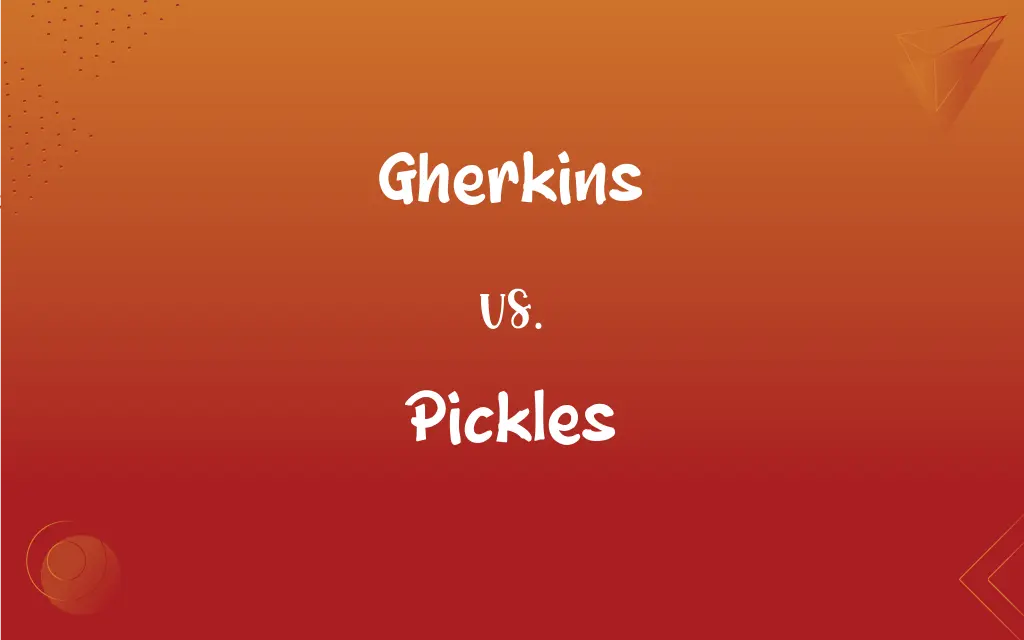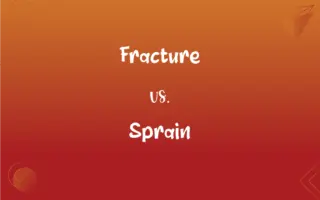Gherkins vs. Pickles: What's the Difference?
Edited by Aimie Carlson || By Harlon Moss || Updated on July 27, 2024
Gherkins are a type of small cucumber, while pickles refer to cucumbers preserved in vinegar or brine.

Key Differences
Gherkins and pickles both relate to the world of preserved foods, particularly cucumbers. However, they are not entirely the same. Gherkins refer to a specific variety of small cucumber that's often pickled, while pickles are a general term for cucumbers that have been preserved in a mixture of vinegar, salt, and spices.
Many people often think of gherkins as the small, crunchy pickles served with sandwiches or appetizers. In contrast, pickles can come in various sizes and flavors, from large dill pickles to sweet bread-and-butter pickles.
When you buy gherkins at the store, they are typically already pickled. They are known for their bumpy skin and crisp texture. On the other hand, pickles can be made from various cucumber varieties and can differ significantly in taste, texture, and appearance based on the pickling process.
One could argue that all gherkins are pickles, but not all pickles are gherkins. This distinction is based on the specific variety of cucumber used and the method of preservation.
In certain regions and cultures, the terms gherkins and pickles might be used interchangeably. Still, it's essential to understand that while all pickled gherkins are pickles, not every pickle you encounter will be a gherkin.
ADVERTISEMENT
Comparison Chart
Definition
A type of small cucumber
Cucumbers preserved in vinegar or brine
Size
Typically small
Can vary in size
Texture
Known for bumpy skin and crisp texture
Varies based on pickling method and cucumber variety
Variety
Specific variety of cucumber
Can be made from various cucumber varieties
Generalization
All pickled gherkins are pickles
Not all pickles are gherkins
ADVERTISEMENT
Gherkins and Pickles Definitions
Gherkins
Gherkins are a specific variety of small cucumber.
She added gherkins to her salad for an extra crunch.
Pickles
Pickles can vary in flavor, from sweet to sour.
She preferred dill pickles over sweet ones.
Gherkins
Gherkins are commonly pickled for consumption.
Pickled gherkins are a favorite snack at parties.
Pickles
Pickles come in different sizes and shapes.
The jar contained long, sliced pickles.
Gherkins
Gherkins have a distinct bumpy skin.
The gherkins stood out because of their unique texture.
Pickles
Pickles are cucumbers preserved in a vinegar or brine solution.
He made homemade pickles using his grandmother's recipe.
Gherkins
Gherkins are often served with sandwiches or appetizers.
The platter had cheese, meat, and gherkins.
Pickles
Pickles undergo fermentation in their preservation process.
The pickles had a tangy taste due to fermentation.
Gherkins
Gherkins have a crisp texture when pickled.
She enjoyed the crispy bite of the gherkins.
Pickles
Pickles can be eaten alone or used in various dishes.
She added chopped pickles to her tuna salad.
Gherkins
A small cucumber, especially one used for pickling.
Pickles
An edible product, such as a cucumber, that has been preserved and flavored in a solution of brine or vinegar.
FAQs
Why are gherkins bumpy?
The bumpy texture is a characteristic of the gherkin variety of cucumber.
Are all pickles made from gherkins?
No, pickles can be made from various cucumber varieties, not just gherkins.
Can you make pickles from vegetables other than cucumbers?
Yes, many vegetables, like carrots and beans, can be pickled.
Why are pickles often served with sandwiches?
The tangy flavor of pickles complements the savory ingredients of sandwiches.
Are pickles high in sodium?
Yes, due to the preservation process, pickles can be high in sodium.
What gives pickles their sour taste?
The vinegar or brine solution, along with fermentation, gives pickles their tangy flavor.
How long can you store pickles?
Properly preserved pickles can last for up to two years unopened, but always check for signs of spoilage.
Do gherkins have seeds?
Yes, gherkins have seeds, but they are usually small and soft.
What's the difference between dill pickles and bread-and-butter pickles?
Dill pickles are tangier and can be spicy, while bread-and-butter pickles are sweeter.
Are pickled gherkins good for health?
In moderation, they can be a low-calorie snack rich in vitamins, but watch out for sodium content.
Why are some pickles crunchy while others are soft?
The crunchiness depends on the cucumber variety, freshness, and pickling process.
Are gherkins always pickled?
While they are commonly pickled, gherkins can also be eaten fresh.
Are gherkins and baby pickles the same?
While similar, not all baby pickles are gherkins; it depends on the cucumber variety used.
What are gherkins?
Gherkins are a type of small cucumber, often pickled for consumption.
How are pickles made?
Pickles are made by preserving cucumbers in a solution of vinegar, salt, and spices, often undergoing fermentation.
Can I make pickled gherkins at home?
Absolutely, with fresh gherkins, vinegar or brine, and your choice of spices, you can make them at home.
Are pickles a vegetable or a fruit?
Botanically speaking, cucumbers are fruits, but in culinary terms, they're often treated as vegetables.
Can I use gherkins in salads?
Yes, gherkins, whether pickled or fresh, can be a crunchy addition to salads.
Can I eat gherkins raw?
Yes, gherkins can be eaten raw and are similar in taste to regular cucumbers.
Do gherkins grow on vines or bushes?
Gherkins grow on trailing or climbing vines.
About Author
Written by
Harlon MossHarlon is a seasoned quality moderator and accomplished content writer for Difference Wiki. An alumnus of the prestigious University of California, he earned his degree in Computer Science. Leveraging his academic background, Harlon brings a meticulous and informed perspective to his work, ensuring content accuracy and excellence.
Edited by
Aimie CarlsonAimie Carlson, holding a master's degree in English literature, is a fervent English language enthusiast. She lends her writing talents to Difference Wiki, a prominent website that specializes in comparisons, offering readers insightful analyses that both captivate and inform.
































































